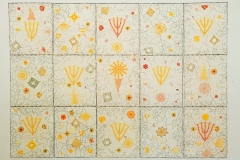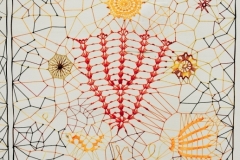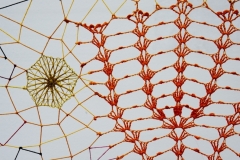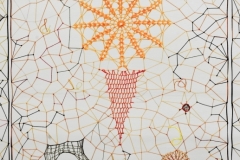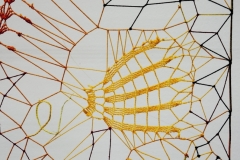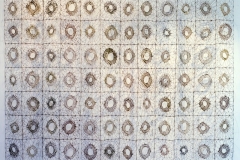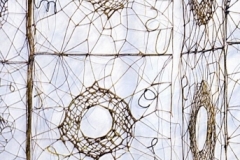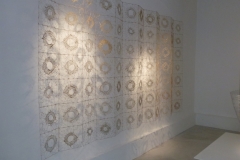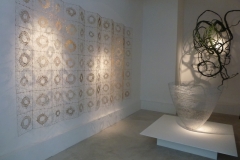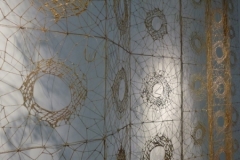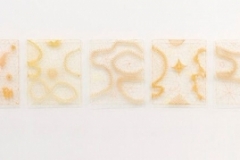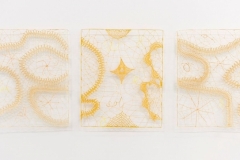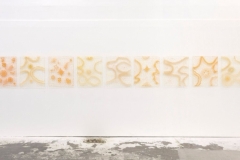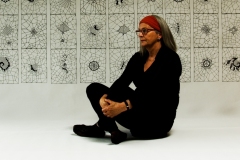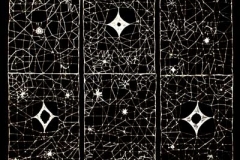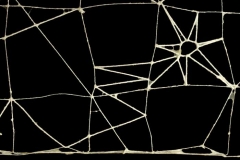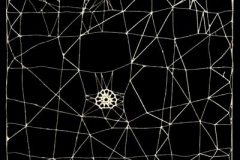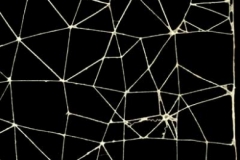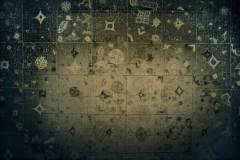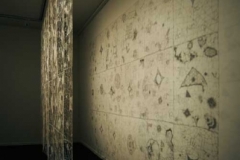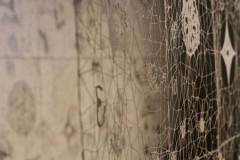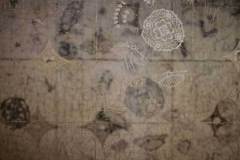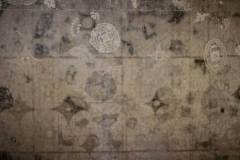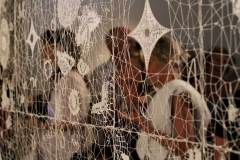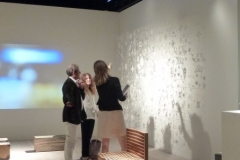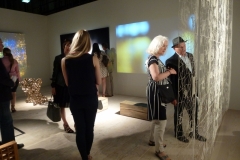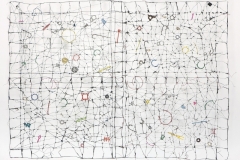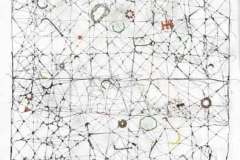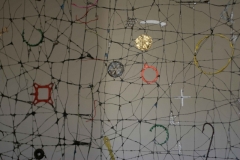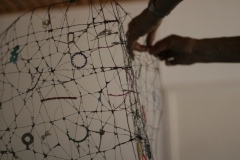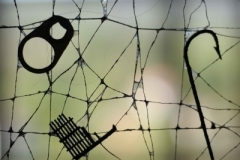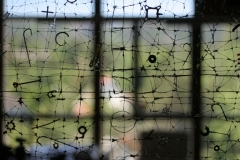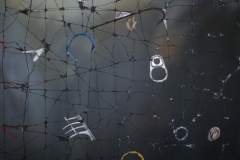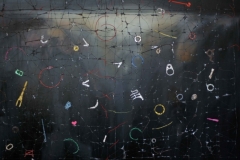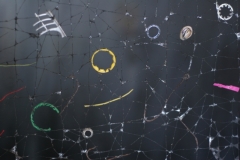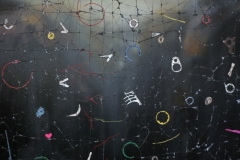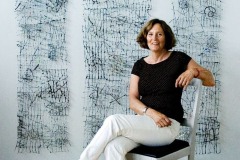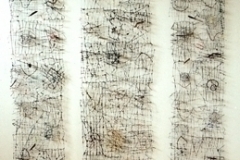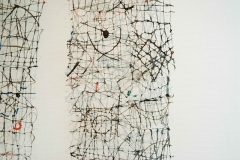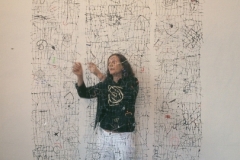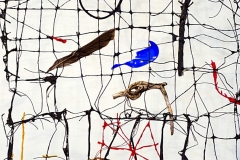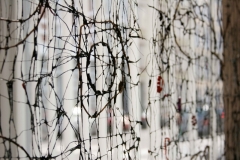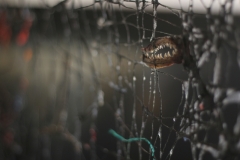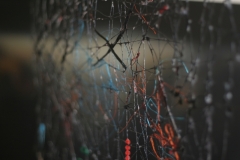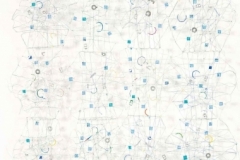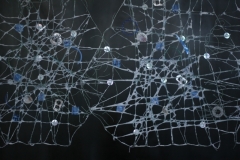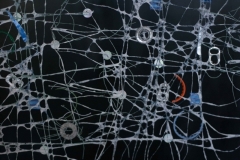Midnight Blue
2018
200 x 240 cm Cotton and linen threads, crochet and knit elements, lacework and macrame. Cellulose glue and pigment.
When I was a student, in my twenties, I learned weaving and dying techniques. I was fascinated by indigo dying: As long as the material is in the dye bath it has no color, but lifted up from the bath it quickly combines with oxygen and becomes intense blue.
So, after many years, I found a bunch of indigo colored linen and cotton thread from my student days, and got the idea to make an artwork out of it. That means it took like 45 years from the material was dyed until it ended up in an artwork!
Coral Sea
2016
180×250 cm Cotton and linen thread, glue, macrame, crochet/knitting, various lace techniques.
I grew up on an island where we were often fishing with nets. Not only fish were caught in the nets; there could be crabs, shell and other creatures from the bottom. Sometimes there would be corals, “sea trees” that we called them. They were often big and had bright red, yellow or other colors, that after a while would fade away. In my fantasy they were greetings from a mysterious world deep down there, colorful and fantastic, unlike the world we lived in.
Aurum
2015
175×280 cm Linen and cotton threads, flax fibres, metal pigment. Knitting and lace techniques.
In the northwestern fjords of Norway, people have made laces for centuries. Liturgy textiles and folk costumes have been decorated with lace, and especially the metal lace was popular.
It looks very much like the lace from the Toulouse region in France from early 17th century. Ernst Zeisler, a Norwegian expert in this particular field, has proposed the interesting hypothesis that it might have something to do with the Huguenots, who were expelled from France in the 17th century because of their religious beliefs. Some of them actually ended up in Norway, and it is a known fact that they brought with them carrot seeds and the art of making lace.
It is interesting that a group of refugees might be the source of what we today consider our national heritage. It is also interesting to think that while the lace tradition abroad was associated with the rich bourgeoisie, in Norway it was the peasants that decorated their costumes with silk, silver and gold. The story about the Huguenots and the art they brought with them inspired me to do my own version of the metal lace, AURUM, as a kind of homage to the expelled people.
Solaris
2015
180×200 cm Macrame, crochet/knitting and various lace techniques
Solaris is a tribute to the Sun. The Sun, center of the Solar System, is the source of all life and energy on earth. People have since the beginning of history understood the importance of the Sun, and it therefore has been the center of many ancient cultures mythologies. It is forever the bringer of all light and life, and its significance is unchanged, despite modern, scientific understanding of the Sun.
Gul
2015
450×60 cm, each element 50×60 cm. Laces, crochet and macrame.
Arakne
2012
170×235 cm Laces, crochet and macrame.
Mytholgy is for me a never ending source of inspiration, and relating to history and mythology is a way to deal with what is happening in todays world. Like life itself the mythological symbols are complex, profound and interesting, not immediately easy to catch or understand.
In Greek mythology Arakne was a talented weaver. She challenged Athena, the goddess of wisdom and crafts, to a weaving contest. This happening resulted in, in the end, Arakne being transformed into a spider.
Astra
2012
170×235 cm Crochet laces, network, flax fibres.
I have many artworks where stars play a role, like here: Astra is the plural form of the Latin word astrum/star.
Here, now
2011
350 x 235 cm Network, cotton-thread, crochet laces, flax fibres.
People live their lives between chaos and cosmos. Where forces of nature and war create chaos, a new order develops, but always different from how it was before the forces moved in. Our surroundings are in a constant change.
But the ideas are always there, universally human and always valid. Many of the archaic myths deal with how the forces of chaos and the forces of nature collide. The archetypes, such as the snake/serpent, the world tree and the cross shape/crucifix exist in many cultures, and express the experience of fundamental disorder and order in the world.
I seek to make connections between history and the present, between different cultures, and between culture and nature. It also deals with modern mans place in nature, where organic structures link up with human forms.
And it deals with traces of a life lived and what was/ the past, and time passing and a changing existence. And the illusion of being able to hold on for a moment to a here, now…
Kapp Mitra and Kapp Linné
2005
110 x 120 cm Network, linen thread, flax fibres, found objects.
Throughout my life I have collected items from the beaches and other places; shells and bones, bottle tops and textile fragments; materials that might otherwise be considered garbage.
As a teenager I made a series of what I called «material works» from objects found on the beach.
About forty years later, the summer of 2004 I stayed for a month at Svalbard, the Norwegian archipelago in the Arctic Ocean. Wandering along the shores, I collected small items, everything from fish bones to man -made objects of metal and plastic. They were integrated in my nets, as a new sort of «material works», like Kapp Mitra, 2005 and Kapp Linné, 2005.
Fenris
2005
150 x 245 cm Network. Linen thread, flax fibres, found objects.
Voluspa; the Song of the Sybil, is one of the most important epic poems of Norse mythology: the sun turns black and falls into the sea, before the world is destroyed and a new world is born.
Since the early 90s I have made many artworks with inspiration from Voluspa, like Black Sun,1995 and Fenris, 2004. Fenris refers to the Fenris Wolf who was chained by Gleipnir, a chain as soft as silk, with many intricate components. If it broke, the wolf would get loose and cause Ragnarok (doomsday).
Venus Fasciata
2004
110 x 140 cm Network. Linen thread, flax fibres, found objects.
I have spent much time looking for items on the beaches, and as a child I was a passionate collector of shells.
The sea shell «Venus Fasciata» gave name to this artwork; one of the first where shells and bones were integrated into the net, together with metal rings and plastic capsules. Though environmentalism is an underlaying theme here; a reflection on the relationship between nature and culture, it has also with pure joy and creativity to do!
